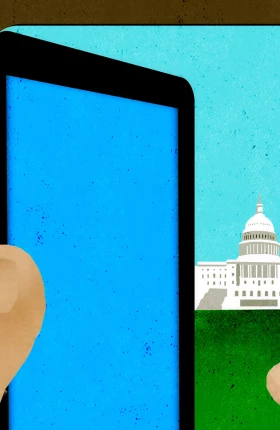Public agencies rarely match the private sector in online experiences. By taking a customer-centric approach, they can even the score—and serve people better.
A government may be of the people, by the people, but its digital services aren’t often built around the people. Approval ratings are low: just 63% of respondents to BCG’s 2022 Digital Government Citizen Survey reported satisfaction with online services. That’s a score that, in the private sector, would trigger board meetings and blood pressure screenings.
An unfair comparison? Not anymore. When users log in to a government website, they aren’t comparing their experience with what Finland or the State of New Jersey delivers. They’re comparing it with Amazon and JPMorgan Chase. They expect interactions on par with commercial sites and apps. And largely, they aren’t getting them.
That can change. When governments get digital right, they see—and trigger—a cascade of benefits. Services have a greater impact and are more accessible. Better experiences mean increased trust in government. Satisfaction scores rise, but so do job creation and economic growth. When a small enterprise has a simple path for filing documents and obtaining licenses, it can get down to business, and expand its business, faster.
How to get there? It starts with looking at the user—whether a resident, small business, or government employee—as a customer. A big part of digital transformation is building services and journeys with customer needs, preferences, and behaviors always top of mind. By taking a customer-centric approach, public agencies can deliver intuitive and efficient experiences. And they can better support, and empower, those they serve.
Transforming the Customer Experience
The COVID-19 crisis put digital services on the marquee, giving them a starring role in how we work and live. But for many government services, waiting in line has been replaced by waiting online, with users searching through a myriad of outdated agency websites. BCG’s survey—which comprised 28,200 participants across 41 countries—found that 71% of respondents had encountered issues online, including technical glitches, lengthy process times, cumbersome navigation, and, simply, an inability to find what they needed. (See the exhibit.)
Stay ahead with BCG insights on the public sector
Already, countries like Singapore and New Zealand are pursuing a more customer-centric approach, designing experiences around life events like the birth of a child. The idea is to make the journey—not the agency—the focal point. A new parent shouldn’t have to access different platforms run by different agencies using different interfaces to do the things new parents need to do, such as registering a birth or scheduling vaccinations. They shouldn’t risk missing an important service simply because they didn’t know it was available to them. Instead, parents in these countries use a single app or site that incorporates all components of the journey.
This kind of integration is a key tenet of an executive order President Biden issued in
That’s no small ask. Public agencies typically operate in a siloed fashion, each with its own processes, data, and IT infrastructure (often composed of legacy systems that don’t play well with others). So how do you bring together the services that the journey, or the life event, requires?
There are a couple of options. One idea is to create a digital front door—a jumping-off point for related services run by different agencies. The advantage here is that you can create a sort of one-stop shopping fairly quickly. But that speed comes at a price. With each service still under the purview of its “home” agency (with its own IT environment and design choices), it’s hard to ensure seamless, consistent experiences across the journey.
A second option is to create an independent agency that takes ownership of service delivery. This new organization doesn’t replace the home agencies, but it’s responsible for designing, managing, and supporting their services (or at least a subset of them) across digital and physical channels. In essence, you bake in the coordination and integration. Users see the same interface and even the same terminology throughout the experience. They navigate quickly and fluidly across the steps of their journey, even when that means accessing services from different agencies.
Not surprisingly, we think this second approach has the edge. But it’s a much more ambitious undertaking than a digital front door, and as the saying goes, ideas are easy—execution is everything.
Lessons from Oklahoma
That caveat about execution is what makes a multiyear transformation in Oklahoma so instructive. The Sooner State is looking not just to improve consistency and efficiency across channels but to create an experience on par with best-in-class private sector players. Anchoring this effort is a new service agency that will take responsibility for omnichannel delivery of services.
Oklahoma is looking not just to improve consistency and efficiency across channels but to create an experience on par with best-in-class private sector players.
From the start, Oklahoma has followed a customer-centric approach, the fruits of which are taking form in a new digital hub for government
Oklahoma’s effort is built around five design principles that accelerate the benefits of the new-agency approach but also recognize—and tackle—its challenges. These principles don’t work in isolation. They fuel one another. For government organizations looking to transform their own service delivery, these are best practices that work best together.
View the experience through the customer’s eye. Digital leaders know the lesson well: to make the customer experience your focus, you need to understand your customer. Human-centered design (HCD) involves users closely in product development, helping you generate key feedback and insights—regarding needs, preferences, behaviors, and limitations—and incorporate them in your design. Whether your customer is a resident, employee, or business, HCD techniques like ethnographic research (including interviews and observations) and iterative testing allow you to view experiences, pain points, and solutions through that customer’s eyes. Using this lens, you can ensure that you are building the right solution to the right problem.
In Oklahoma, for example, designers discovered that there were times when customers wanted to interact in real time with agency employees, but other times when they preferred to perform the process on their own schedule. To give customers this flexibility, Oklahoma prioritized support for synchronous/asynchronous services.
Get to value quickly. By steadily building out the central hub, you steadily create value for both agencies and residents instead of waiting years for a grand unveiling. The idea: think big but start small (focusing on a few high-volume services) and scale fast. Quick wins also demonstrate, often quite visibly, the power of the customer-centric approach, boosting buy-in from stakeholders—support that helps fund the journey.
Developing services incrementally lets you apply the lessons you learn with each wave so that your process (and ideally, your speed and efficiency) continually improves. It also lets you build your internal capabilities—the skills, data, and other elements required to deliver the target experiences—steadily, as well. This is particularly important in the public sector, as government agencies typically can’t hire all the necessary talent as rapidly as private sector companies. It’s faster, and more realistic, to develop just the capabilities you need to launch the current wave of services. Then, in the next wave, you expand that foundation, adding any capabilities your new services require.
Let technology accelerate, not hinder, your progress. None of this works without thinking carefully about technology. That’s because tech can cut two ways. It can facilitate the rapid development of customer-focused experiences but can also encumber it. Many organizations—and government agencies tend to top the list here—have an IT infrastructure based on older, less flexible (or completely inflexible) legacy systems. To build the best customer experience, using HCD, you need to design features and journeys without worrying about how the final product ties into your back end. You need to separate your journey decisions from your technical decisions. And, in keeping with the private sector’s mantra of speed to market, you need to launch new experiences quickly.
How do you avoid compromises and delay? In Oklahoma, the answer has a couple of components. The first is to embrace low-code and no-code solutions. Using drag-and-drop interfaces, developers can create applications—whether web services or mobile apps—with minimal (or even zero) coding. That fosters speed: rapid cycles in which designers can seek and incorporate user feedback for works in progress. Meanwhile, the simplicity of low- and no-code solutions means that nonengineers can be developers, too, enabling those well versed in HCD but perhaps less proficient in programming to play a key role in getting services and journeys off the ground.
The second part of the equation: make the most of what you already have in place. Savvy agencies will take a close look at their IT portfolio before embarking on new initiatives. They’ll identify where they might tap or repurpose systems and resources that they already possess. Many organizations, particularly in the public sector, have technology they don’t fully use. Leveraging these assets, where possible, can lower the costs—and technical debt—incurred by new projects, while accelerating the pace of development and deployment.
Embrace agile and a culture of collaboration. Speed and flexibility are boosted further via agile ways of working. In our experience, agile can deliver a 10% to 20% increase in customer satisfaction, two to four times faster delivery of new products, and 15% to 25% reductions in development costs. The public sector can reap these same rewards, too, which is why agile principles—including cross-functional teams, frequent iterations, and continually seeking out and applying feedback—are at the heart of Oklahoma’s public services project.
Agile is about more than processes. It’s also about building a mindset: a test-and-learn culture where collaboration and continual improvement are ingrained in the organization’s DNA (and evangelized from the top). A key lesson from Oklahoma is how collaboration—particularly in the form of co-creation—can help a public agency develop its in-house talent. By mixing external partners and internal staff on development teams, Oklahoma initiated a two-way knowledge transfer. The outside experts gained insight on how processes worked and what customers needed. But just as crucially, the state’s personnel saw key techniques and methodologies in action and developed their own skills. So when the outside experts leave the field, the internal talent can run with the ball, ready and able to lead subsequent waves.
Focus relentlessly—from the start—on outcomes and metrics. Finally, how do you know that the experience you’ve built is working for your customers? The right KPIs can provide valuable insight on outcomes and improvements: how initiatives are faring and where to focus follow-on work. But it’s important to think about those metrics right from the beginning and understand your starting point as well as your goal. By developing a baseline, you create alignment, upfront, on what you’re trying to fix and what success looks like. Oklahoma’s approach was to baseline performance, efficiency, and satisfaction. This meant looking at KPIs such as the number of credentials issued, backlogs, wait and service times, and customer satisfaction (CSAT) scores.
The right metrics will vary across organizations, but there are some rules of thumb. KPIs should align with the outcomes you seek (in the private sector, many organizations look at CSAT and customer loyalty scores to gauge the overall effectiveness of the customer experience). They should also be timely and accessible. The goal is to get a snapshot of performance in as close to real time as possible. That insight becomes a guide. You may have built an excellent customer experience—but it can always be an even better one.
Digital can be a great enabler, simplifying and enriching interactions between government and those it serves. But public agencies need to take a new approach if they are to match the private sector on the customer experience. This means focusing on needs and journeys, and building a foundation for speed, flexibility, and continual improvement. It’s an approach that pays its first dividends quickly and creates more value over time. It can help government realize the full potential of digital—and residents realize the full potential of government.







